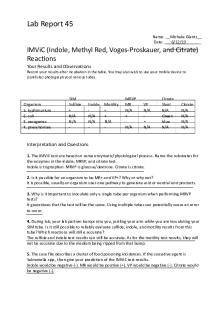Lab Exercise 44 PDF

| Title | Lab Exercise 44 |
|---|---|
| Author | Michele Glantz |
| Course | Microbiology Laboratory |
| Institution | Broward College |
| Pages | 2 |
| File Size | 65.9 KB |
| File Type | |
| Total Downloads | 40 |
| Total Views | 176 |
Summary
Lab exercise typed out...
Description
Lab Report 44 Name: __Michele Glantz__ Date: ___6/11/19_______
Litmus Milk Your Results and Observations Draw your results or photograph them with your mobile device and describe the result and its interpretation in the table.
E. coli
Organism
Alcaligenes faecalis
Escherichia coli
Result (appearance/color of the medium) Litmus is pink
Alcaligenes faecalis
Litmus is a light purple
Bacillus cereus
Litmus is dark purple at the top, lighter purple throughout, and a brownish/”tealike” color towards the bottom
Bacillus cereus
Interpretation Bacterium has fermented lactose, acid is produced Alkaline reaction associated with the breakdown of the protein casein Digestion is starting, the milk is starting to clear
Interpretation and Questions 1. The ability of Bacillus cereus to cause disease is associated with the ability it has to produce secreted toxins or exoenzymes. These include emetic toxin, hemolysins, enterotoxins, and
Lab Report 44 protease. Which of these toxins or exoenzymes would be involved in the growth of B. cereus in litmus milk? Bacillus cereus produces an enterotoxin & can cause food poisoning (intoxication), including one form that is often associated with fried rice held for hours at warm temperatures, associated with the growth in litmus milk.
2. As described in the previous question, B. cereus produces emetic toxin, hemolysis, enterotoxins, and proteases. Which of the media used in exercises 14-17 could be used to detect one of these toxins or exoenzymes? Why? In exercise 17, the MacConkey Agar is able to differentiate between non-lactose fermenters and lactose fermenters. It is useful in the identification of enteric bacteria, and acid is produced and released into the medium during the fermentation of lactose. Like it in the Litmus Milk test, if the organism ferments lactose, acid is produced. Both give off a color change when acid is produced, and lactose is fermented....
Similar Free PDFs

Lab Exercise 44
- 2 Pages

Lab Exercise 1 - lab
- 1 Pages

Module 44 - Lecture notes 44
- 3 Pages

Lab Exercise 1 - Lab work
- 3 Pages

Lab Exercise 2 - lab work
- 3 Pages

Page 44
- 1 Pages

Lab Exercise 46
- 2 Pages

Lab 10 Exercise
- 4 Pages

LAB Exercise 5 - practice
- 25 Pages

COMP301Lab05 - Lab Exercise 5
- 2 Pages

Lab 8 Exercise
- 5 Pages

Lab Exercise 16
- 2 Pages

Lab Exercise 29
- 3 Pages

Lab Exercise 23
- 2 Pages

ICT502 Lab Exercise 3
- 6 Pages

Lab Exercise 45
- 1 Pages
Popular Institutions
- Tinajero National High School - Annex
- Politeknik Caltex Riau
- Yokohama City University
- SGT University
- University of Al-Qadisiyah
- Divine Word College of Vigan
- Techniek College Rotterdam
- Universidade de Santiago
- Universiti Teknologi MARA Cawangan Johor Kampus Pasir Gudang
- Poltekkes Kemenkes Yogyakarta
- Baguio City National High School
- Colegio san marcos
- preparatoria uno
- Centro de Bachillerato Tecnológico Industrial y de Servicios No. 107
- Dalian Maritime University
- Quang Trung Secondary School
- Colegio Tecnológico en Informática
- Corporación Regional de Educación Superior
- Grupo CEDVA
- Dar Al Uloom University
- Centro de Estudios Preuniversitarios de la Universidad Nacional de Ingeniería
- 上智大学
- Aakash International School, Nuna Majara
- San Felipe Neri Catholic School
- Kang Chiao International School - New Taipei City
- Misamis Occidental National High School
- Institución Educativa Escuela Normal Juan Ladrilleros
- Kolehiyo ng Pantukan
- Batanes State College
- Instituto Continental
- Sekolah Menengah Kejuruan Kesehatan Kaltara (Tarakan)
- Colegio de La Inmaculada Concepcion - Cebu